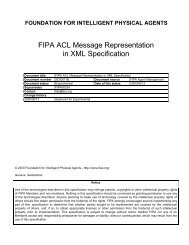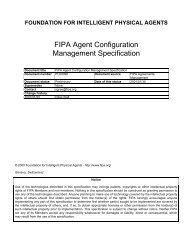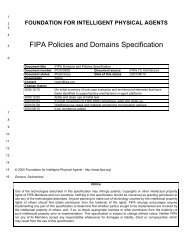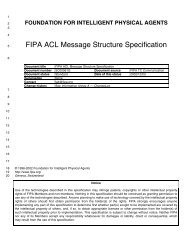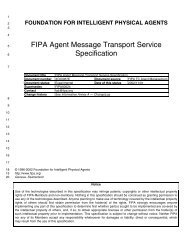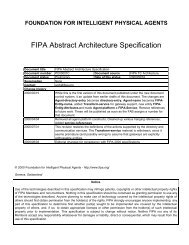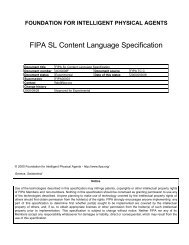FIPA ACL Message Structure Specification
FIPA ACL Message Structure Specification
FIPA ACL Message Structure Specification
You also want an ePaper? Increase the reach of your titles
YUMPU automatically turns print PDFs into web optimized ePapers that Google loves.
© 2000 Foundation for Intelligent Physical Agents <strong>FIPA</strong> <strong>ACL</strong> <strong>Message</strong> <strong>Structure</strong><br />
171<br />
172<br />
173<br />
174<br />
175<br />
176<br />
177<br />
178<br />
179<br />
180<br />
181<br />
182<br />
183<br />
184<br />
185<br />
186<br />
187<br />
188<br />
189<br />
190<br />
191<br />
192<br />
193<br />
194<br />
195<br />
196<br />
197<br />
198<br />
199<br />
200<br />
201<br />
2.5 Control of Conversation<br />
2.5.1 Protocol<br />
Element Description Reserved Values<br />
protocol Denotes the interaction protocol that the sending agent is<br />
See [<strong>FIPA</strong>00025]<br />
employing with this <strong>ACL</strong> message.<br />
Notes: The protocol message element defines the interaction protocol in which the <strong>ACL</strong> message is generated. This<br />
element is optional; however, developers are advised that employing <strong>ACL</strong> without the framework of an interaction<br />
protocol (and thus directly using the <strong>ACL</strong> semantics to control the agent’s generation and interpretation of <strong>ACL</strong><br />
messages) is an extremely ambitious undertaking.<br />
2.5.2 Conversation Identifier<br />
Element Description Reserved Values<br />
conversation Introduces an expression (a conversation identifier) which is used<br />
-id<br />
to identify the ongoing sequence of communicative acts that<br />
together form a conversation.<br />
Notes: An agent may optionally tag <strong>ACL</strong> messages with a conversation identifier to manage its communication<br />
strategies and activities. Typically this will allow an agent to identify individual conversations with multiple agents. It will<br />
also allow agents to reason across historical records of conversations.<br />
2.5.3 Reply With<br />
Element Description Reserved Values<br />
reply-with Introduces an expression that will be used by the responding<br />
agent to identify this message.<br />
Notes: This message element is designed to be used to follow a conversation thread in a situation where multiple<br />
dialogues occur simultaneously. For example, if agent i sends to agent j a message which contains:<br />
reply-with <br />
Agent j will respond with a message containing:<br />
in-reply-to <br />
2.5.4 In Reply To<br />
Element Description Reserved Values<br />
in-reply-to Denotes an expression that references an earlier action to which<br />
this message is a reply.<br />
Notes: See notes for Section 2.5.3, Reply With.<br />
2.5.5 Reply By<br />
Element Description Reserved Values<br />
reply-by Denotes a time and/or date expression which indicates the latest<br />
time by which the sending agent would like to have received a<br />
reply.<br />
5



